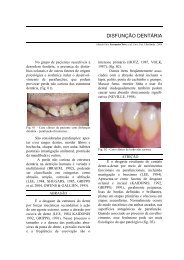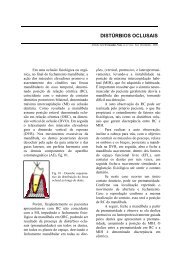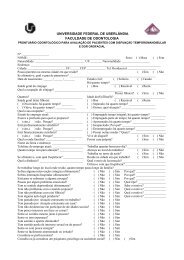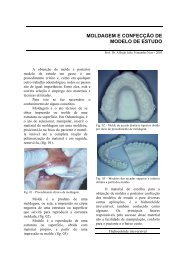Influence of cavity preparation design on fracture resistance of ...
Influence of cavity preparation design on fracture resistance of ...
Influence of cavity preparation design on fracture resistance of ...
You also want an ePaper? Increase the reach of your titles
YUMPU automatically turns print PDFs into web optimized ePapers that Google loves.
THE JOURNAL OF PROSTHETIC DENTISTRY SOARES ET AL<br />
Fig. 7. Representative <strong>fracture</strong> modes observed after compressive loading test. A, Inlay. B, Onlay covering 1 cusp. C, Onlay<br />
covering all buccal cusps. D, Onlay covering all cusps.<br />
<strong>fracture</strong> <str<strong>on</strong>g>of</str<strong>on</strong>g> either the restorative material or dental structure,<br />
is an important method for improving restorative<br />
procedures. 1,2,10,12,16,17,28 There are a number <str<strong>on</strong>g>of</str<strong>on</strong>g> factors<br />
that may interfere with <strong>resistance</strong> to <strong>fracture</strong>, such<br />
as the tooth embedment method, type <str<strong>on</strong>g>of</str<strong>on</strong>g> load applicati<strong>on</strong><br />
device, and crosshead speed. 8 Thus, the experimental<br />
methods used for in vitro analyses do not faithfully<br />
represent real clinical c<strong>on</strong>diti<strong>on</strong>s, in which failures occur<br />
primarily due to fatigue. 18 To minimize the discrepancy<br />
between experimental assessments and clinical failures,<br />
different methods have been used, such as the joint<br />
use <str<strong>on</strong>g>of</str<strong>on</strong>g> mechanical tests and <strong>fracture</strong> mode analysis according<br />
to predefined scales. 8,17,19<br />
Mechanical <strong>fracture</strong> tests are performed to numerically<br />
quantify the influence <str<strong>on</strong>g>of</str<strong>on</strong>g> restorative material<br />
types, 2,10,16,17,19,20 luting procedures, 12,21 and <str<strong>on</strong>g>preparati<strong>on</strong></str<strong>on</strong>g><br />
characteristics 14,22 for <strong>resistance</strong> to <strong>fracture</strong><br />
when submitted to a c<strong>on</strong>centrated and increasing load.<br />
These tests usually produce failure loads that exceed<br />
the load limit exerted by normal stomatognathic system<br />
movements. 33 In spite <str<strong>on</strong>g>of</str<strong>on</strong>g> this fact, higher loading situati<strong>on</strong>s<br />
can be compared to the situati<strong>on</strong> in which the<br />
individual grinds a solid body <str<strong>on</strong>g>of</str<strong>on</strong>g> small dimensi<strong>on</strong>s and<br />
the force that would be distributed over the occlusal<br />
surfaces <str<strong>on</strong>g>of</str<strong>on</strong>g> posterior teeth is c<strong>on</strong>centrated over a single<br />
tooth. If this tooth is structurally debilitated or prepared<br />
with an inadequate <str<strong>on</strong>g>cavity</str<strong>on</strong>g> <str<strong>on</strong>g>design</str<strong>on</strong>g>, the result may be<br />
<strong>fracture</strong> <str<strong>on</strong>g>of</str<strong>on</strong>g> the tooth, the restorati<strong>on</strong>, or both.<br />
When performing mechanical tests, some factors are<br />
important to more closely approximate the clinical situati<strong>on</strong>,<br />
such as the root embedment method to simulate<br />
the period<strong>on</strong>tal membrane, the loading apparatus, and<br />
the mode <str<strong>on</strong>g>of</str<strong>on</strong>g> load transmissi<strong>on</strong>. 8 The simulati<strong>on</strong> <str<strong>on</strong>g>of</str<strong>on</strong>g> the<br />
period<strong>on</strong>tal ligament should be d<strong>on</strong>e with an elastomeric<br />
material that is able to undergo elastic deformati<strong>on</strong><br />
and reproduce the accommodati<strong>on</strong> <str<strong>on</strong>g>of</str<strong>on</strong>g> the tooth<br />
in the alveolus, providing the n<strong>on</strong>c<strong>on</strong>centrati<strong>on</strong> <str<strong>on</strong>g>of</str<strong>on</strong>g><br />
stresses in the cervical regi<strong>on</strong> <str<strong>on</strong>g>of</str<strong>on</strong>g> the tooth. Moreover, a<br />
simulated period<strong>on</strong>tal ligament is highly influential <strong>on</strong><br />
the <strong>fracture</strong> pattern. 23 In this experiment, a polyether<br />
impressi<strong>on</strong> material was used in associati<strong>on</strong> with a polystyrene<br />
resin as an adequate method for <strong>fracture</strong> <strong>resistance</strong><br />
tests. 17,24<br />
Occlusal loading is another important factor. Burke<br />
et al 8 and Burke and Watts 9 c<strong>on</strong>cluded that the best<br />
method for measuring the <strong>resistance</strong> <str<strong>on</strong>g>of</str<strong>on</strong>g> premolars to<br />
<strong>fracture</strong> is the use <str<strong>on</strong>g>of</str<strong>on</strong>g> a cylinder <str<strong>on</strong>g>of</str<strong>on</strong>g> a defined diameter. 19<br />
The use <str<strong>on</strong>g>of</str<strong>on</strong>g> a 6-mm steel sphere for <strong>resistance</strong> to <strong>fracture</strong><br />
testing by Dietschi et al 25 and Soares et al 17 was shown<br />
to be ideal for molars because it c<strong>on</strong>tacts the functi<strong>on</strong>al<br />
and n<strong>on</strong>functi<strong>on</strong>al cusps in positi<strong>on</strong>s close to those<br />
found clinically.<br />
The results <str<strong>on</strong>g>of</str<strong>on</strong>g> the present study showed that the mean<br />
<strong>resistance</strong> to load <str<strong>on</strong>g>of</str<strong>on</strong>g> healthy teeth (IT:3143.1 6 635.5<br />
N) was significantly higher than the <strong>resistance</strong> to load<br />
<str<strong>on</strong>g>of</str<strong>on</strong>g> teeth prepared with different types <str<strong>on</strong>g>of</str<strong>on</strong>g> <str<strong>on</strong>g>preparati<strong>on</strong></str<strong>on</strong>g>s<br />
and restored with a Leucite-reinforced ceramic; thus,<br />
the null hypothesis was rejected. This dem<strong>on</strong>strates<br />
that the restorative process, even when adhesive techniques<br />
are associated with cuspal coverage, is not able<br />
to restore the total <strong>resistance</strong> to load <str<strong>on</strong>g>of</str<strong>on</strong>g> healthy molars.<br />
This result is in agreement with the studies <str<strong>on</strong>g>of</str<strong>on</strong>g> Morin<br />
426 VOLUME 95 NUMBER 6









